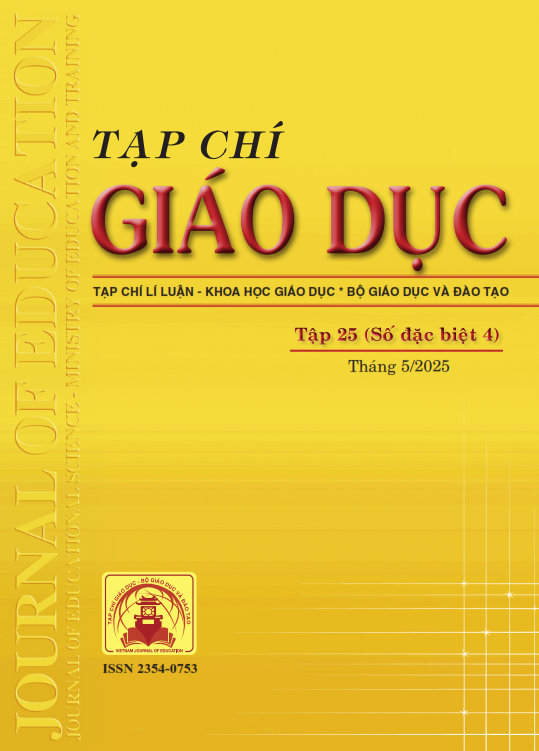Thiết kế bản đồ khái niệm chủ đề “Xác suất” (Toán 11) trong dạy học với sự hỗ trợ của trí tuệ nhân tạo (AI)
Tóm tắt
Concept maps effectively connect and classify information by visualizing the organization, hierarchy, and relationships between concepts. However, designing CMs can be challenging for students as it requires reorganizing knowledge in a personalized way. In modern mathematics education, AI supports students in structuring and systematizing knowledge. This study examines the effectiveness of AI-assisted student interactions in designing and interpreting CMs in Probability. Based on an experimental research method combined with qualitative analysis, our study shows that AI can assist students in structuring concept maps, improving their ability to recognize individual concepts, and identifying relationships between concepts within a complex network. The research findings contribute to proposing an AIintegrated model in mathematics education to help students personalize their learning paths, enhance self-directed learning, and improve knowledge acquisition in mathematics. Future research should consider the benefits of AI interaction in fostering students’ personal development.
Tài liệu tham khảo
Afamasaga-Fuata, K. (2009). Concept mapping in mathematics. New York: Springer.
Chevallard, Y. (1991). La transposition didactique: Du savoir savant au savoir enseigné (2e éd.). La Pensée Sauvage.
Chik, V., Plimmer, B., & Hosking, J. (2007). Intelligent mind-mapping. In Proceedings of the 19th australasian conference on computer-human interaction: entertaining user interfaces (pp. 195-198).
Ciechanowski, L., Przegalinska, A., Magnuski, M., & Gloor, P. (2019). In the shades of the uncanny valley: An experimental study of human-chatbot interaction. Future Generation Computer Systems, 92, 539-548.
Erdem, E., Yilmaz, A., & Oskay, Ö. Ö. (2009). The effect of concept mapping on meaningful learning of atom and bonding. Procedia - Social and Behavioral Sciences, 1(1), 1586-1590.
Evans, T., & Jeong, I. (2023). Concept maps as assessment for learning in university mathematics. Educational Studies in Mathematics, 113(3), 475-498.
Gross, M. D. (1994). Stretch-A-Sketch: A dynamic diagrammer. In Proceedings of the 1994 IEEE Symposium on Visual Languages (pp. 232-238). IEEE.
Happs, J. C., & Mansfield, H. (1989). Students' and Teachers' Perceptions of the Cognitive and Affective Outcomes of Some Lessons in Geometry. Annual Meeting of the American Educational ReSearch Association, SanFrancisco, CA, United States.
Hwang, G. J., Lin, Y. C., & Lin, H. C. (2023). Associating spatial knowledge with concept maps to facilitate learning in digital gaming contexts. Educational Technology Research and Development, 71(6), 2221-2241.
Karpicke, J. D., & Blunt, J. R. (2011). Retrieval practice produces more learning than elaborative studying with concept mapping. Science, 331(6018), 772-775. https://doi.org/10.1126/science.1199327
Lê Thị Hoài Châu, Comiti, C. (2018). Thuyết nhân học trong Didactic Toán. NXB Đại học Sư phạm Thành phố Hồ Chí Minh.
Leauby, B. A., Szabat, K. A., & Maas, J. D. (2010). Concept mapping - An empirical study in introductory financial accounting. Accounting Education: An International Journal, 19(3), 279-300.
Lin, Y., & Yu, Z. (2023). Extending Technology Acceptance Model to higher-education students’ use of digital academic reading tools on computers. International Journal of Educational Technology in Higher Education, 20(1), 34.
Litvin, D. R., & Betters-Reed, B. L. (2005). The personal map: A lesson in similarities, differences, and the invisible. Journal of Management Education, 29(2), 199-217. https://doi.org/10.1177/1052562903261079
Marzetta, K., Mason, H., & Wee, B. (2018). ‘Sometimes They Are Fun and Sometimes They Are Not’: Concept Mapping with English Language Acquisition (ELA) and Gifted/Talented (GT) Elementary Students Learning Science and Sustainability. Education Sciences, 8(1), 13.
Moran, T. P., Chiu, P., van Melle, W., & Kurtenbach, G. (1995, May). Implicit structures for pen-based systems within a freeform interaction paradigm. In Proceedings of the SIGCHI Conference on Human Factors in Computing Systems (pp. 487-494). ACM. https://doi.org/10.1145/223904.223970
Novak, J. D. (2010). Learning, creating, and using knowledge: Concept maps as facilitative tools in schools and corporations. Routledge.
Novak, J. D., & Cañas, A. J. (2006). The origins of the concept mapping tool and the continuing evolution of the tool. Information Visualization, 5(3), 175-184. https://doi.org/10.1057/palgrave.ivs.9500126
Panjaburee, P., Hwang, G. J., Triampo, W., & Shih, B. Y. (2010). A multi-expert approach for developing testing and diagnostic systems based on the concept-effect model. Computers & Education, 55(2), 527-540.
Saund, E., Fleet, D., Larner, D., & Mahoney, J. (2003, November). Perceptually-supported image editing of text and graphics. In Proceedings of the 16th annual ACM symposium on User interface software and technology (pp. 183-192).
Shneiderman, B. (2020). Human-centered artificial intelligence: Reliable, safe & trustworthy. International Journal of Human-Computer Interaction, 36(6), 495-504.
Stanford Institute for Human-Centered Artificial Intelligence (2020). Letter from the HAI leadership team. https://hai.stanford.edu
Yadav, P. (2023). Use of concept mapping as a pedagogical tool to foster meaningful learning in mathematics at the middle education stage. International Journal of Educational Research Open, 4, 100250.
Đã Xuất bản
Cách trích dẫn
Số
Chuyên mục
Giấy phép

Tác phẩm này được cấp phép theo Ghi nhận tác giả của Creative Commons Giấy phép quốc tế 4.0 .












